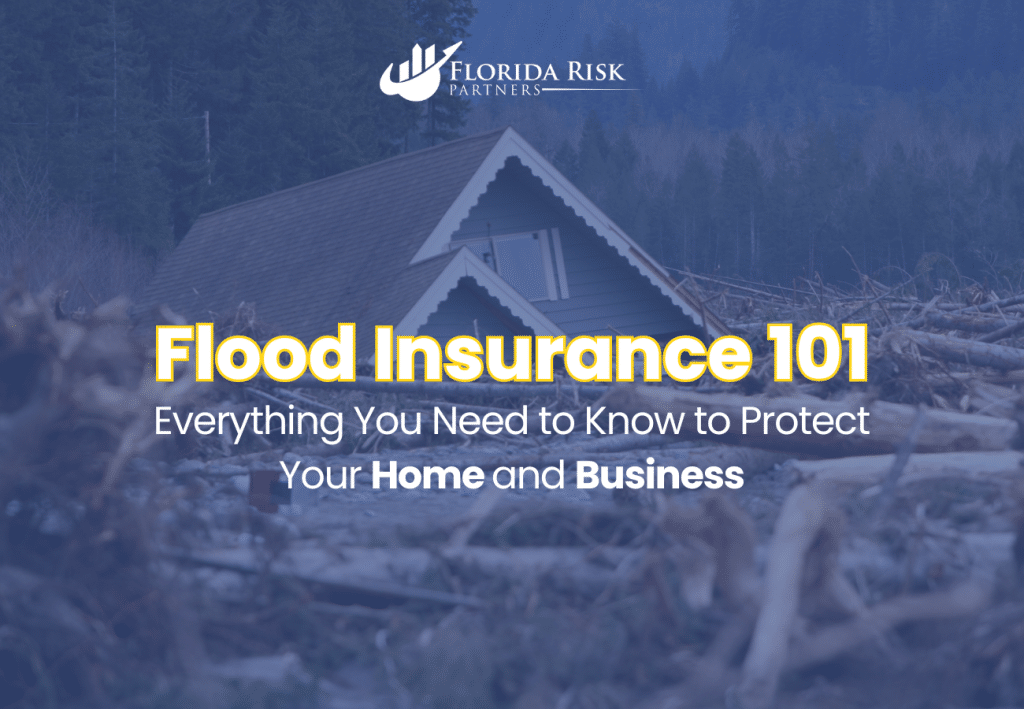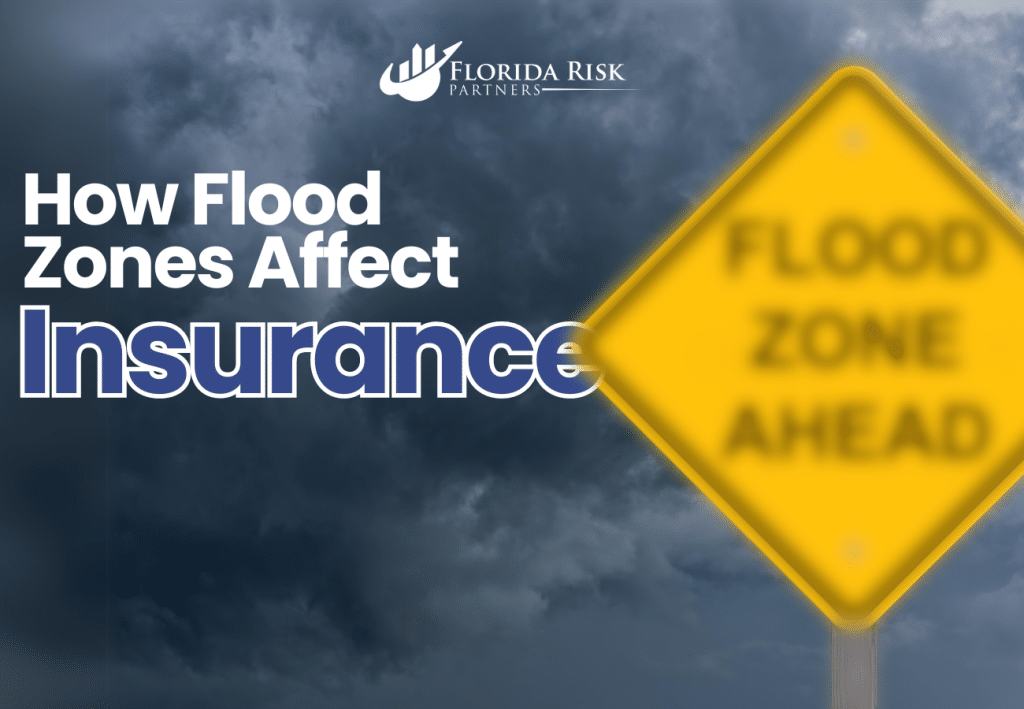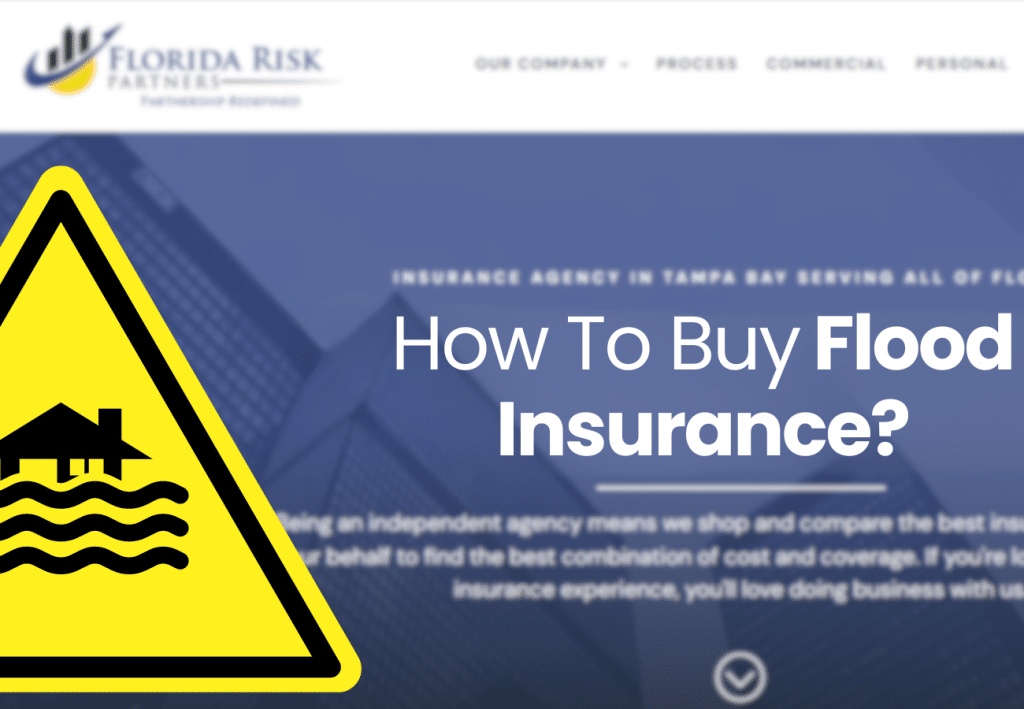-
Main Office: 1434 E. Bloomingdale Ave Valrico, FL 33596-6110
-
Phone: (888) 601-6660
-
Email: info@floridariskpartners.com

Flooding is one of the most common and costly natural disasters in the United States, yet many homeowners and business owners still don’t carry flood insurance. This is a problem, especially in areas like Florida, where heavy rains and hurricanes frequently cause flood damage. Unfortunately, there’s a common misconception that flood damage is covered under standard homeowners or business property insurance policies—it’s not.
Flood insurance is an essential form of protection for any property owner, whether residential or commercial. It provides coverage in the event that your home or business experiences flood damage. In this comprehensive guide, we’ll break down everything you need to know about flood insurance: why it’s necessary, what it covers, how to understand flood zones, and more. This post serves as a foundation for educating you about flood insurance and is the first in a series that will explore the topic in greater depth.
Why Flood Insurance Is Important
Floods are the most frequent natural disaster in the United States, and they can happen anywhere—not just in high-risk flood zones. According to the National Flood Insurance Program (NFIP), a flood is defined by FEMA as:
A general and temporary condition of partial or complete inundation of 2 or more acres of normally dry land area or of 2 or more properties (at least 1 of which is the policyholder’s property) from:
- Overflow of inland or tidal waters; or
- Unusual and rapid accumulation or runoff of surface waters from any source; or
- Mudslides (i.e., mudflows) which are proximately caused by flooding and are akin to a river of liquid and flowing mud on the surfaces of normally dry land areas, as when earth is carried by a current of water and deposited along the path of the current.; or
- Collapse or subsidence of land along the shore of a lake or similar body of water as a result of erosion or undermining caused by waves or currents of water exceeding anticipated cyclical levels that result in a flood as defined above.
A flood inundates a floodplain. Most floods fall into three major categories: riverine flooding, coastal flooding, and shallow flooding. Alluvial fan flooding is another type of flooding more common in the mountainous western states.
This definition highlights that flooding doesn’t just occur near rivers or coastlines; heavy rains, hurricanes, or overflowing drainage systems can cause flood damage even in areas considered low-risk.
Most homeowners and business property insurance policies do not cover flood damage. This means that if your property is damaged by a flood and you don’t have flood insurance, you’ll be responsible for covering all the repair and replacement costs out of pocket. Flood insurance is crucial because it can be the difference between financial ruin and recovery.
What’s more, floods don’t just affect high-risk areas. FEMA reports that more than 20% of flood claims come from properties located outside of high-risk flood zones. So even if you think your property is “safe,” you could still experience flooding. Learn more about flood insurance options here to protect your property before disaster strikes.
What Flood Insurance Covers
Flood insurance policies typically provide two types of coverage: building coverage and contents coverage.
- Building Coverage: This part of the policy covers the structure of your home or business. It includes things like the foundation, electrical and plumbing systems, HVAC equipment, and built-in appliances (such as a water heater or furnace). In the event of a flood, building coverage helps pay for repairs or even the complete reconstruction of the property.
- Contents Coverage: This portion of your policy covers personal belongings within your home or business. This includes furniture, electronics, clothing, and in the case of a business, equipment or inventory. After a flood, contents coverage helps you replace these items without dipping into your savings or business revenue.
It’s important to note that flood insurance for personal properties differs from commercial flood insurance. While homeowners will be primarily concerned with replacing personal belongings and repairing structural damage, businesses often have more at stake in terms of machinery, equipment, and inventory that must be replaced. To get a detailed breakdown of what flood insurance covers, explore flood insurance coverage options here.
How Flood Zones Affect Insurance

Flood zones are geographic areas defined by FEMA that indicate the level of risk for flooding. These zones determine the cost of flood insurance and whether flood insurance is required for certain properties. Here’s a breakdown of the different flood zones and their significance:
- High-Risk Flood Zones (Special Flood Hazard Areas – SFHA): These areas have at least a 1% annual chance of flooding, commonly referred to as the “100-year floodplain.” If your property is located in one of these zones, flood insurance is mandatory if you have a mortgage from a federally regulated or insured lender.
- Moderate- to Low-Risk Flood Zones: In these areas, flooding is less likely, but it can still occur. Properties in these zones aren’t required by law to have flood insurance, but coverage is still highly recommended, especially since over 20% of flood claims come from outside high-risk areas.
- Undetermined Risk Zones: These areas haven’t been fully assessed for flood risk. It’s important to stay aware of any updates to flood mapping in these regions, as risks may be higher than anticipated.
Even if you’re not in a high-risk zone, flood insurance is worth considering. The costs of recovering from flood damage can easily surpass the annual premiums for flood coverage. To see what flood zone your property is in, check your flood zone now here.
The Cost of Flood Insurance
The cost of flood insurance varies based on several factors, including your property’s location, the flood zone, the value of the property, and the coverage limits you choose. Properties located in high-risk flood zones will generally have higher premiums, but even properties in moderate- to low-risk zones should consider coverage, as premiums in these areas are often much lower.
For example, flood insurance for a home in a low-risk zone might cost only a few hundred dollars per year, while premiums in a high-risk zone could be several thousand dollars annually. Commercial flood insurance tends to be more expensive than residential coverage, primarily due to the higher property values and additional risk factors associated with operating a business.
There are ways to reduce your flood insurance premiums. Elevating your home above the base flood elevation (BFE) can significantly lower costs. Additionally, certain mitigation efforts like installing flood barriers or improving your property’s drainage system can help.
To get an estimate of what flood insurance would cost for your specific property, calculate your flood insurance premium here with our online premium calculator.
How to Buy Flood Insurance
Purchasing flood insurance is a straightforward process, but it’s important to understand your options. There are two primary sources for flood insurance: the National Flood Insurance Program (NFIP) and private flood insurance providers.
- NFIP Flood Insurance: The NFIP is a government-backed program that offers flood insurance to homeowners, renters, and businesses in participating communities. It provides building coverage of up to $250,000 for residential properties and up to $500,000 for commercial properties, with additional coverage for contents. NFIP policies are widely available, and premiums are often based on standardized rates, depending on your flood zone and property risk.
- Private Flood Insurance: Private flood insurance policies are an alternative to NFIP coverage. These policies can offer higher coverage limits and more flexibility in terms of deductibles and endorsements. In some cases, private insurers may provide lower premiums than the NFIP, particularly for properties in low- to moderate-risk zones.

Before purchasing a policy, evaluate the coverage limits, deductibles, and exclusions of both NFIP and private insurance options. Be sure to consider your specific needs, especially if you’re insuring a business or a high-value home. Start your flood insurance purchase here by contacting us or using our online quote tool.
Common Myths About Flood Insurance
There are several misconceptions about flood insurance that often prevent people from getting the coverage they need. Let’s clear up some of the most common myths:
- Myth 1: “I’m not in a flood zone, so I don’t need flood insurance.”
Fact: Flooding can occur anywhere, and more than 20% of flood insurance claims come from properties outside of high-risk flood zones. Flooding can result from a variety of causes, including heavy rain, hurricanes, or even overflowing drainage systems. Even if you’re in a low-risk area, flood insurance is still a wise investment. - Myth 2: “Federal disaster assistance will cover flood damage.”
Fact: Federal disaster assistance is only available if the President declares a disaster, and even then, the aid typically comes in the form of a low-interest loan that must be repaid. Flood insurance provides direct compensation for covered losses, without the need for federal aid. - Myth 3: “Flood insurance is too expensive.”
Fact: The cost of flood insurance varies depending on your location, flood zone, and coverage limits, but it’s often much more affordable than people assume. Additionally, the cost of flood insurance is far less than the financial burden of paying out of pocket for flood damage repairs.
Discover the truth about flood insurance here and protect your property from unexpected disaster.
Real-Life Examples of Flood Damage
To understand the importance of flood insurance, consider real-life stories of homeowners and business owners who suffered flood damage, both with and without insurance.
For example, a Florida homeowner in a moderate-risk flood zone didn’t think they needed flood insurance. After heavy rains caused their home to flood, they were left with over $50,000 in repair costs—and no insurance to cover the expenses. On the other hand, a business owner in the same area had a commercial flood insurance policy that helped cover the costs of replacing damaged equipment and inventory, allowing them to reopen their business quickly.
Flood damage is often more extensive and costly than people realize. See more real flood damage examples here to understand why having flood insurance can make all the difference.
The Future of Flooding: Climate Change and Increasing Risks
As climate change progresses, the frequency and severity of floods are expected to increase. Rising sea levels, stronger storms, and changing weather patterns are all contributing to higher flood risks in areas that were previously considered low-risk. Even properties that are inland or away from traditional flood zones are becoming more vulnerable.
This shift in flood risk is also affecting flood zones and insurance rates. Properties that once had low premiums may see increases as flood risks evolve. It’s essential to stay ahead of these changes by securing flood insurance now and reassessing your coverage as needed.
To learn more about how climate change is affecting flood risks, get ahead of climate risks and secure flood insurance now here.
Conclusion: Protect Your Property Before It’s Too Late
Flood insurance is an essential investment for homeowners and business owners alike. It protects you from the financial devastation that flooding can cause and ensures that you have the resources needed to rebuild or recover. Whether your property is in a high-risk or low-risk zone, flood insurance is the best way to secure peace of mind.
Don’t wait for disaster to strike. Get your flood insurance quote now here and protect your home or business today.
Call Us Or
Schedule an Appointment
Select an agent below to view our online calendars and select a day and time that works best for you or call us directly at 888-601-6660. When you use our online calendars, you will receive an email with more information.



